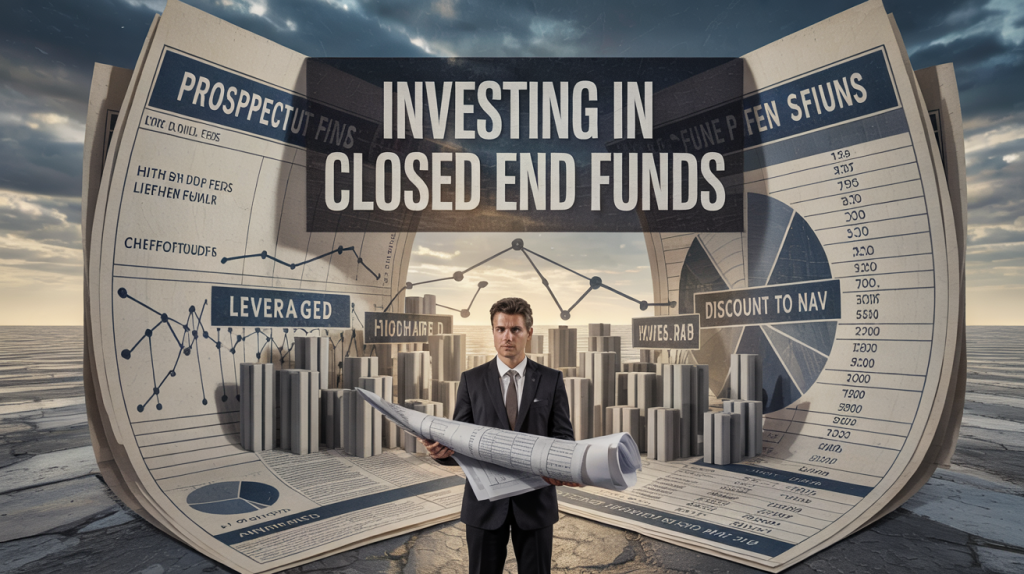
Everything You Need to Know About Investing in Closed End Funds—From Discounts to Dividends and Beyond
Introduction: The Opportunity Hiding in Plain Sight
If you’ve spent any time exploring income investments, you’ve probably come across closed-end funds (CEFs)—and maybe skipped past them. They’re often lumped together with mutual funds and ETFs, yet behave nothing like either. In fact, most investors don’t fully understand how closed-end funds work, how they’re priced, or why they can be a source of consistent returns and attractive discounts for the right kind of investor.
This misunderstanding creates opportunity. And as a value investor, that’s exactly what you want—assets priced below their intrinsic value. In this article, you’ll learn why investing in closed-end funds could be one of the most overlooked ways to generate reliable income and long-term returns in your portfolio.
What Is a Closed End Fund—and Why It’s Different from an ETF
Most investors think of funds as open-ended vehicles like mutual funds or ETFs, which create or redeem shares daily to meet demand. Closed-end funds are different. They issue a fixed number of shares at IPO and trade on the stock exchange like stocks. That means prices can fluctuate based on supply and demand, not just NAV.
Because of this structure, CEFs can—and often do—trade at discounts or premiums to their net asset value. Unlike ETFs, which are constantly arbitraged back to NAV, closed-end funds offer the unique chance to buy assets at a persistent discount. This is where the misunderstanding begins—and where the opportunity lies.
The Discount to NAV: Why It Exists and How You Can Profit
One of the most powerful concepts in investing in closed-end funds is the discount to NAV. It’s exactly what it sounds like: the market price of the fund trades below the total value of the underlying assets.
This pricing inefficiency happens for several reasons—lack of analyst coverage, investor behavior, or simply because most people don’t know how to value them properly. But to a value-oriented investor, this inefficiency is a gift. You can buy a dollar’s worth of assets for 80 or 90 cents—and collect income while waiting for the market to close the gap.
Discounts also tend to widen in bear markets or when investors rush for liquidity. But these very moments offer the best opportunities for the patient buyer.
How Closed End Funds Deliver Income—And Why the Yields Are Often Higher
CEFs are popular among income investors because they tend to offer significantly higher yields than mutual funds or ETFs. This is due to three main factors: use of leverage, active management, and a focus on income-generating assets such as bonds, dividend stocks, or real estate investment trusts (REITs).
Unlike open-ended funds, closed-end funds can borrow at institutional rates to enhance returns. While this adds risk, it also allows them to distribute more income—especially in lower interest rate environments. This leverage, when managed properly, can supercharge returns without needing to stretch for risky underlying assets.
The Role of Active Management in Closed End Funds
In an age where passive investing dominates headlines, closed end funds are unapologetically active. These funds are typically run by experienced managers with specific mandates—be it municipal bonds, emerging markets, preferred stocks, or high-yield debt.
This active approach gives them flexibility to rotate the portfolio, manage risk, and exploit pricing anomalies. But it also adds complexity. Investors need to evaluate not just the portfolio but also the manager’s track record and the fund’s structural characteristics, including fees and leverage. For the informed investor, this is not a drawback—it’s a chance to gain an edge.
Liquidity, Volatility, and Market Perception: What to Expect When Buying CEFs
Because closed end funds trade like stocks, their price can fluctuate wildly—often more than the underlying NAV. This creates both risk and opportunity. Thin trading volumes can exaggerate price moves, especially during market stress. That’s why many closed-end funds can be found trading at deep discounts after sharp corrections.
But if you understand the underlying value and are not forced to sell, this volatility can work in your favor. Over time, discounts tend to narrow, and mean reversion can deliver additional upside on top of the income.
How to Get Started Investing in Closed End Funds (Without Getting Burned)
If you’re new to closed-end funds, don’t jump in based solely on yield. Focus on understanding the fund’s strategy, underlying assets, distribution sustainability, and discount history. You’ll also want to examine the use of leverage and whether distributions are sourced from income, capital gains, or return of capital.
Use resources like Stock Rover, Morningstar, or CEFConnect to evaluate the fund’s NAV, discount/premium, and historical performance. And always use limit orders when purchasing—some CEFs are thinly traded and spreads can be wide.
Start with a small allocation and build as your understanding deepens. Closed-end funds reward informed, patient investors who know how to buy value and avoid yield traps.
Conclusion: A Market Segment Hiding in Plain Sight
Closed end funds aren’t for everyone. They require more due diligence, a steady hand, and a value-oriented mindset. But for investors willing to do the work, they offer a compelling blend of income, discount capture, and active management.
In a world awash with crowded trades and passive flows, CEFs remain one of the few areas where inefficiencies are common—and profit potential is real. If you’re serious about generating income and buying value, you can’t afford to ignore them any longer.

Shailesh Kumar, MBA is the founder of Astute Investor’s Calculus, where he shares high-conviction small-cap value ideas, stock reports, and investing strategies.
His work has been featured in the New York Times and profiled on Wikipedia. He previously ran Value Stock Guide, one of the earliest value investing platforms online.
Subscribe to the Inner Circle to access premium stock reports and strategy insights.
Featured in:



